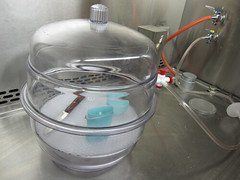Team:Alberta/Notebook/ReusablePlates
From 2010.igem.org
Creating Inexpensive and Reusable Plates
Project Timeline: Click on an image to see more information

The equipment and supplies required to sterilize and make plates are expensive and not usually available to a high school lab. We attempted to create plates which could easily be sterilized by a microwave or bleach.
Scintered Plastic Plates
Scintered Plastic Supplier: SPC technologies Ltd.
We used 3 types of scintered plastic:
- 3.0mm Ultra-Fine PE sheet(14um pore-size)
- ultra-fine grade should be a bacterial barrier
- 6.0mm Fine-Grade PE Sheet(30um pore-size)
- fine grade should also be a bacterial barrier but it was too hard to cut
- 4.5mm Medium Grade PE Sheet(88um pore-size)
Procedure:
- tested plastic's ability to absorb LB
- June 22, 2010 - added 10ml of LB and 40ul chloramphenicol to plates made from the 3.0mm and 4.5mm scintered plastics. Incubated in a 37C warm room overnight.
- June 23, 2010 - 7ml LB left in 3.0mm ultra-fine and 8ml left in 4.5mm medium-grade
- Streaking on Plastic
- June 23, 2010 - streaked both types of scintered plastic with RFP-containing colonies(after transferring plastic into new petri dishes). Left in 37C warm room overnight.
- June 24, 2010 - no growth after incubation, plastic was very dry
L.B.O
Creation of "L.B.O.": a deodorant stick of LB agar
- June 24, 2010 - All of the following steps were performed in a safety cabinet under sterile conditions.
- disassembled a Degree deodorant stick and soaked in ethanol
- removed the raising platform and covered it with Parafilm
- coated the insides of the tube with mineral oil
- removed platform and poured LB agar into the base of the stick, waited until it solidified
- the Parafilmed platform was put back into the stick and lowered maximally
- LB agar was poured on top of the platform, until the tube was full, waited until it solidifed
- The top of the LB agar was sliced off with an ethanol-sterilized knife
- 400ul of transformed competent cells were plated on the stick as if it was a standard LB agar plate
- L.B.O. stick was incubated overnight at 37C

- although the knife cut through the LB agar easily, it was difficult to produce a completely flat surface
- solidified LB agar was effectively raised and lowered using the dial
- after incubation, a bacterial lawn was observed and a distinct E.coli smell was present
- June 29, 2010
- Followed procedure from June 26, 2010 to put new LB agar into the L.B.O. tube
- Approximately 1cm was sliced off the top of the new LB agar with an ethanol-sterilized razor blade
- L.B.O. stick was incubated overnight at 37C
Observations:
- no growth observed, tube must have been sterile
- June 30, 2010
- Streaked green colony from a plate of Cambridge parts
- L.B.O. stick was incubated overnight at 37C
Observations:
- green streak and individual green colonies observed, along with a distinct E.coli smell
- July 5, 2010
- Approximately 1cm was sliced off the top of the used LB agar with an ethanol-sterilized razor blade
- Streaked red, RFP-containing colony onto the LB agar surface.
- L.B.O. stick was incubated overnight at 37C
Observations:
- only a red streak and individual red colonies observed, along with a distinct E.coli smell
- no remnants of green colonies visible
Jello and Gelatine Plates
Used two types of Jello:
- Jell-o brand, raspberry flavor:
- sweetened with aspartame (no sugar added)
- 125mg sodium per 2.5g
- 1g protein per 2.5g
- 2. Knox brand Gelatine
Procedure (July 26, 2010): Jello:
- Stir two cups boiling water into 10g powder until dissolved
- pour into petri dishes
- chill for 2 hours until set
Gelatine:
- stir 175ml milli-Q water into 15ml gelatine
- stir in 175ml hot milli-Q and pour into petri dishes
- put in cold room until set (approx 2hours)
After 2 hours (Gelatine and Jello):
- Spread BBa_k274003(dark green stain of E.coli) onto 2 jello and 2 gelatine plates
- incubate overnight at 37C
Results: Both Jello and Gelatine plates had liquefied and no growth was seen.
 "
"
